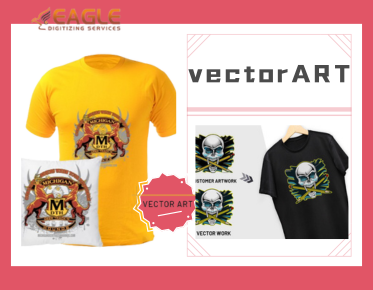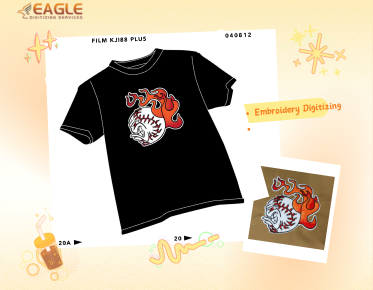Embroidery Solutions: Go Green with Eco-Friendly Fabrics
As sustainability
becomes increasingly important, embroidery enthusiasts
are turning to eco-friendly fabrics to reduce their environmental impact.
Whether you're crafting personalized gifts or creating professional designs,
choosing green materials can make a big difference. In this article, we'll
explore the benefits of eco-friendly fabrics for embroidery, from organic
cotton to recycled textiles, and how they can elevate both your designs and
your eco-conscious values. Ready to stitch with a purpose? Let’s dive into the
world of sustainable embroidery solutions!
The Impact of Fabric Choices on the Environment
The fashion and
textile industry is notorious for its environmental footprint. From
deforestation to water contamination, the impact of conventional fabric
production is staggering. By opting for eco-friendly fabrics, embroiderers can
mitigate the damage, creating art that contributes to a greener, cleaner world.
Understanding Eco-Friendly Fabrics: What Makes Them Green?
Defining
Eco-Friendly Fabrics: Beyond the Buzzword
Eco-friendly
fabrics are more than just a catchy phrase. They are materials produced with
minimal environmental impact, often sourced from sustainable crops or recycled
fibers. Their production involves fewer chemicals, less water, and
energy-saving processes, making them a beacon of responsible manufacturing.
The
Difference Between Organic and Sustainable Fabrics
While both terms
are often used interchangeably, there is a nuanced difference. Organic fabrics
are made from crops grown without synthetic pesticides or fertilizers, while
sustainable fabrics emphasize broader eco-conscious practices, such as reduced
carbon emissions and energy-efficient production. Understanding these terms
helps crafters make informed decisions.
Certifications
to Look for When Choosing Eco-Friendly Materials
Keep an eye out
for trusted certifications like GOTS (Global Organic Textile Standard) and
OEKO-TEX. These labels ensure that the fabrics meet stringent environmental and
social criteria. They act as a seal of quality and integrity, assuring
embroiderers that their chosen materials adhere to eco-friendly practices.
Popular Eco-Friendly Fabrics for Embroidery
Organic
Cotton: The Sustainable Staple
Soft, breathable,
and versatile, organic cotton is beloved for a reason. It’s easy to work with,
making it ideal for beginners and experienced embroiderers alike. Its
production supports sustainable farming practices, reducing the chemical load
on the planet.
Hemp:
Nature’s Tough and Eco-Friendly Option
Hemp’s durability
is unmatched, making it a preferred choice for projects that demand longevity.
This fabric’s natural texture brings an earthy depth to designs, lending itself
well to rustic and modern embroidery alike.
Linen:
Sustainable, Breathable, and Beautiful
Linen, spun from
flax, is a timeless fabric that embodies elegance and resilience. It absorbs
dyes beautifully, offering a rich palette for intricate designs, and its
production requires significantly less water compared to cotton.
Bamboo
Fabric: Soft, Versatile, and Green
Bamboo fabric is
praised for its silky texture and natural antibacterial properties. Its fast
growth rate makes it a sustainable option, although it’s crucial to ensure that
the processing methods are eco-friendly.
Tencel/Lyocell:
Eco-Friendly and Luxuriously Smooth
Derived from wood
pulp through a closed-loop process, Tencel is the epitome of sustainable
luxury. It drapes beautifully and holds stitches with precision, making it
perfect for detailed, lightweight embroidery projects.
The Benefits of Choosing Eco-Friendly Fabrics for Your Projects
Reducing
Environmental Impact with Every Stitch
Each choice
matters. By using eco-friendly fabrics, you actively participate in reducing
water consumption, lowering greenhouse gas emissions, and supporting practices
that prioritize sustainability.
Supporting
Ethical Practices in the Fashion Industry
Choosing
eco-friendly materials signals to the industry that consumers value
transparency and ethical production. It supports companies that treat their
workers fairly and adhere to humane, environmentally responsible practices.
How
Eco-Friendly Fabrics Enhance Your Embroidery Designs
Sustainable
fabrics often come with unique textures and characteristics that elevate
embroidery work. Their natural properties allow for better color absorption and
a richer final product, giving your designs an extra layer of charm.
Choosing the Right Eco-Friendly Fabric for Your Embroidery
Fabric
Weight and Texture: What’s Best for Your Design
The right fabric
depends on your project's needs. For delicate designs, lightweight organic
cotton or Tencel might be ideal, while heavier pieces may benefit from the
robust quality of hemp or linen.
Considering
Fabric Durability for Long-Lasting Projects
Projects that
will see heavy use, such as clothing or home decor, require fabrics known for
their strength. Hemp and linen excel here, offering durability that ages
gracefully.
How
to Match Fabric to Stitching Techniques
The fabric’s
texture and weight affect how stitches lay and interact with the surface.
Smooth, tightly woven fabrics like Tencel work well with detailed stitches,
while the coarser texture of linen enhances bold, simple patterns.
Organic Cotton: A Beginner’s Best Friend
Why
Organic Cotton is Perfect for Hand and Machine Embroidery
Organic cotton is
versatile and user-friendly. Its forgiving nature makes it an excellent choice
for beginners, whether they are embroidering by hand or using a machine. The
even weave ensures that stitches come out neat and uniform.
How
to Care for Organic Cotton Fabrics
Gentle washing in
cool water preserves the integrity of organic cotton. Using mild detergents and
air drying helps maintain its shape and longevity.
Recommended
Organic Cotton Sources for Embroiderers
Many ethical
brands and online retailers now stock organic cotton specifically for crafting.
Look for suppliers that provide transparency about their sourcing and
production methods.
Linen: Timeless Elegance with an Eco-Friendly Edge
Why
Linen Makes the Perfect Fabric for Intricate Designs
Linen’s slight
sheen and crisp texture make it a standout option for intricate embroidery. Its
natural strength ensures that even the most detailed designs hold their shape
over time.
Working
with Linen: Tips for Embroiderers
Pre-washing linen
reduces shrinkage and makes the fabric more manageable. Keeping it slightly
taut in a hoop prevents puckering during stitching.
The
Environmental Benefits of Linen as a Fiber
Linen is one of
the most eco-friendly fibers due to its minimal need for water and pesticides.
It biodegrades naturally, adding to its sustainability profile.
Hemp Fabric: The Unsung Hero of Sustainable Embroidery
Why
Hemp is the Most Durable Eco-Friendly Option
Hemp's fibers are
naturally tough, making it perfect for embroidery that demands resilience. Over
time, hemp fabrics become softer while maintaining their strength, providing a
lasting canvas for artwork.
How
Hemp Adds Texture and Depth to Your Designs
The textured
surface of hemp can add a unique, rustic touch to designs. Embroidery on hemp
fabric stands out with an organic feel that synthetic materials struggle to
replicate.
Hemp
Blends: A Versatile Option for All Types of Embroidery
Blends like hemp-cotton
or hemp-silk combine the benefits of each fiber, creating versatile fabrics
that work well with various embroidery techniques.
Bamboo Fabric: Softness Meets Sustainability
Why
Bamboo is One of the Fastest-Growing Eco-Friendly Fabrics
Bamboo grows
rapidly without the need for pesticides, making it a highly renewable resource.
But it's crucial to make sure the bamboo cloth is made using environmentally
responsible methods.
How
Bamboo Fabric Complements Embroidery Stitches
With a softness
comparable to silk, the bamboo fabric allows embroidery threads to glide
smoothly, making it ideal for intricate, delicate designs.
The
Pros and Cons of Using Bamboo in Your Projects
While bamboo
fabric has many benefits, some manufacturing processes use chemicals that can
offset its eco-friendly advantages. Choosing suppliers that prioritize
sustainable practices is key.
Tencel and Lyocell: The Luxurious, Eco-Friendly Option
How
Tencel is Made: A Closed-Loop Process for Sustainability
Tencel is
produced using a closed-loop system where nearly all the solvents are reused,
minimizing waste and environmental impact. This process contributes to its
reputation as one of the most sustainable fabrics available.
Why
Tencel is a Great Fabric for Detailed and Lightweight Embroidery
Tencel’s smooth
surface is ideal for intricate embroidery, allowing fine threads to lie flat
and display their full color. It’s lightweight but strong, holding its shape
well under tension.
The
Look and Feel of Tencel: A Designer’s Dream
With its subtle
luster and silky texture, Tencel adds a luxurious finish to embroidery projects. It drapes elegantly, creating
pieces that are both beautiful and comfortable to wear or display.
Recycled Fabrics: Giving Old Materials a New Life
What
Are Recycled Fabrics and How Are They Made?
Recycled fabrics
are created from post-consumer waste, such as plastic bottles or old textiles.
They are processed and spun into new fibers, reducing landfill waste and
conserving resources.
Best
Recycled Fabrics for Eco-Conscious Embroiderers
Recycled
polyester and cotton blends are excellent options for embroiderers who want to
infuse sustainability into their projects. These materials often have a unique
texture that adds character to embroidery.
How
to Work with Recycled Fabrics for Unique Designs
These fabrics may
vary in consistency, so testing on small patches before full-scale projects is
wise. Their slightly irregular texture can add a distinctive touch to designs,
making each creation one of a kind.
The Role of Fabric Dyes in Eco-Friendly Embroidery
Natural
vs. Synthetic Dyes: Which is More Sustainable?
Natural dyes,
derived from plants and minerals, are less harmful to the environment compared
to synthetic ones. However, synthetic dyes have advanced to include low-impact
options that reduce water and chemical use.
Eco-Friendly
Dyeing Techniques: Reducing Chemical Use
Eco-friendly
dyeing practices include using low-impact dyes and natural mordants like
vinegar or alum. These methods lessen the chemical footprint and create colors
that harmonize with the fabric’s natural essence.
How
to Dye Your Fabrics Using Eco-Friendly Methods
Experimenting
with natural ingredients such as turmeric, beetroot, or indigo allows
embroiderers to customize their fabric palette. Simple at-home methods involve
boiling the fabric with plant-based dyes and fixatives for lasting results.
Eco-Friendly Fabrics for Specialty Embroidery Projects
Best
Fabrics for Embroidering on Clothing
Organic cotton
and hemp blends work beautifully for clothing items, balancing comfort and
durability. Tencel is also a fantastic option for garments requiring a touch of
elegance.
Creating
Home Decor with Sustainable Fabrics
Sturdy fabrics
like linen and hemp are perfect for home decor items such as wall hangings and
cushion covers. Their natural textures provide a cozy, refined look that
complements any space.
Using
Eco-Friendly Fabrics for Gifts and Personal Projects
Personalized
gifts made with eco-friendly fabrics show thoughtfulness and care. Hand towels
embroidered on organic cotton or decorative linen tablecloths are sustainable
gifts that friends and family will treasure.
How to Source Eco-Friendly Fabrics for Embroidery
Where
to Find Sustainable Fabrics Online and Locally
Many online
retailers specialize in sustainable textiles, offering a range of eco-friendly
fabrics. Local craft shops and artisan cooperatives often stock unique,
ethically sourced options as well.
Tips
for Identifying Truly Eco-Friendly Fabric Suppliers
Look for
suppliers that provide transparency regarding their production methods and
certifications. Reading reviews and seeking out artisan recommendations can
ensure you’re purchasing genuinely eco-conscious materials.
Supporting
Small Businesses and Artisans in the Eco-Fabric Movement
Choosing
small-scale producers supports not only the eco-fabric industry but also the
livelihoods of artisans who commit to sustainable and fair trade practices.
This adds a personal connection to every embroidered piece.
Embroidery is more than just art—it’s an expression of values, history, and personal style. By embracing eco-friendly fabrics, embroiderers contribute to a broader narrative of sustainability. Each conscious choice stitches a chapter in the story of a cleaner, more responsible world, where creativity flourishes hand-in-hand with nature.


